The role of High Education Institutions (HEIs) in enabling civic engagement towards local impact has arguably been very important. As part of a wider activity within the T-Factor project, experts in the fields of circular and collaborative economy joined forces with universities and practitioners in Bilbao to explore the potential of novel academic curricula to boost collaboration between HEIs and grassroots initiatives. In this context, T-Factor worked together with the University of Mondragon (MU) in the academic year 2022-23. The main objective was to explore how university students could develop a temporary use prototype in response to a local challenge with the active participation of local grassroots initiatives.
This article presents the key activities that MU designed and implemented to foster collaboration between their students and various stakeholders of the Bilbao local community. Ultimately, the goal of this article is not to focus on the exact outcomes of the MU case but rather to understand how the various types of activities deployed have enabled a new way of engaging with grassroots initiatives, and whether this has led to more socially inclusive practices. Consequently, other HEIs and educational organizations may benefit from this experience in building their own transdisciplinary curricula.
The case of Mondragon University in Zorrotzaurre
Zorrotzaurre is an artificial island located in the northwest end of Bilbao, a post-industrial area that is now immersed in a substantive regeneration project. Here, T-Factor’s Bilbao pilot is focused on unleashing the potential of meanwhile uses to find new opportunities to strengthen local communities. Hence, the University of Mondragon was invited by T-Factor to help Zorrotzaurre unlock its transformative potential. Through an academic course, students would develop prototypes and processes that reimagine Zorrotzaurre’s communities based on the principles of circular and collaborative economy. Tecnalia and Universitat Oberta de Catalunya joined the initiative as project partners to provide external feedback during the whole process. The development of this activity was divided into four phases.
1. Exploration
The aim of the exploration phase was to understand the conditions in Zorrotzaurre, make contacts with the stakeholders and identify the local needs. To do so, the Mondragon instructors first defined the scope and objectives of the course, and then created sub-teams to facilitate the process of exploring the area. The students were divided into 7 groups of 3 people, with each group analyzing a different speculative profile based on their diagnosis of Zorrotzaurre.
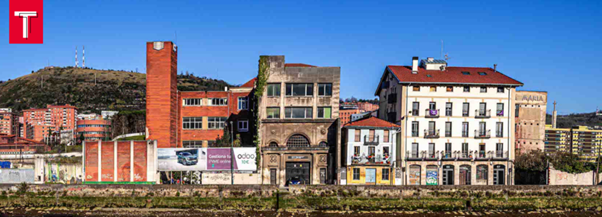
A wide range of tools and methods were used in this process, including: site visits & observation; unstructured interviews; in-depth interviews with selected actors; and swot analyses. The result was a mapping of the different types of actors involved in the area, along with their needs and problems.
As mentioned by the students, the success of the exploration phase was based on the way they approached the local stakeholders. Specifically, showing interest in knowing the people they interacted with and creating environments of trust through active-listening was seen as crucial in this process. Nevertheless, establishing trusted relationships and engagement with local actors was quite challenging for the students.
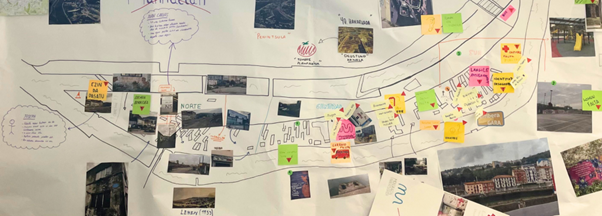
2. Concept Design
The exploration phase and the collected data served as a starting point for the designing of solutions that would meet the actual needs of the local stakeholders. More specifically, the goal of this phase was to design technological solutions that incorporated elements of sustainable human development.
The main activity that supported the design phase was a dedicated workshop held at the MU with the participation of external experts. Starting from their specific needs, students identified potential solutions that applied values from the circular and collaborative economy such as openness, inclusivity, solidarity, and environmental conservation.
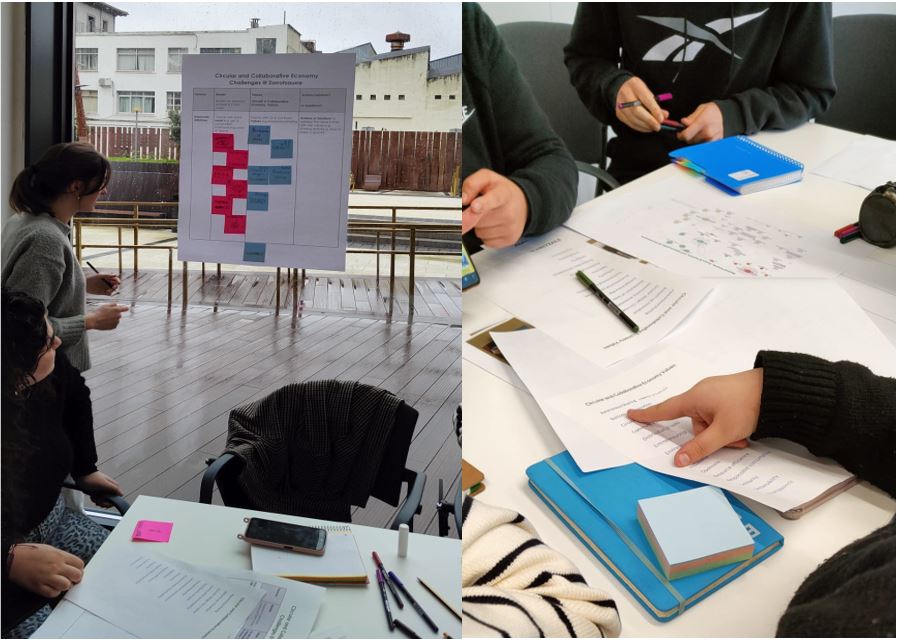
The outcome of this workshop was a group of broadly described solutions, that focused on specific aspects of the area, such as increasing Zorrotzaurre’s visibility through popular events, sharing or swapping resources for different purposes, and a combination of these two ideas.
3. Prototyping
Next was the prototyping phase. At first, students built on the design phase and produced seven presentations where each of the groups described their idea. At this point the students did not develop any hardware skills but focused on graphic design. At the end of this stage, students were asked to choose one of the presented ideas through collective decision-making.
They finally decided to go with a cargo-bike solution, including the development of a software application. The cargo bike was going to be used by homeless immigrants (as “Neighborhood Champions”) to buy food or get it free from the supermarkets in Deusto, the closest neighborhood. This solution was an answer to the fact that there are no supermarkets in Zorrotzaurre. However, after sharing this idea with some grassroot initiatives involved in the design and fabrication process, a decision to change the cargo-bike idea for a “circular hub or resource sharing space” was made. The potential activities around this second option were seen as much more interesting and inclusive.
Once the decision was finalized, the students worked on the development of their fabrication skills (using laser cutters, 3D printers or programming languages) and then proceeded to the manufacturing of the selected prototype, i.e. the Erriberritu.
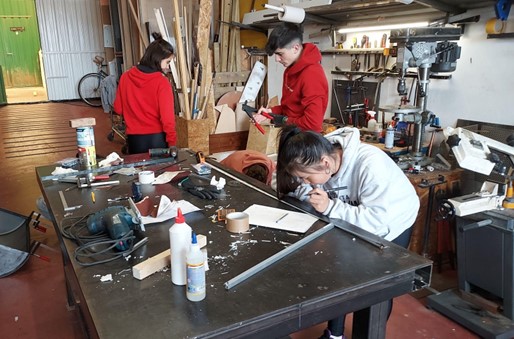
4. Validation
The last phase that took place as part of the academic curriculum was the validation process, which included several stages. The first one was right after the construction of the prototype and it was a presentation that students did for the teachers, the grassroots initiatives and the external experts, explaining the overall process.
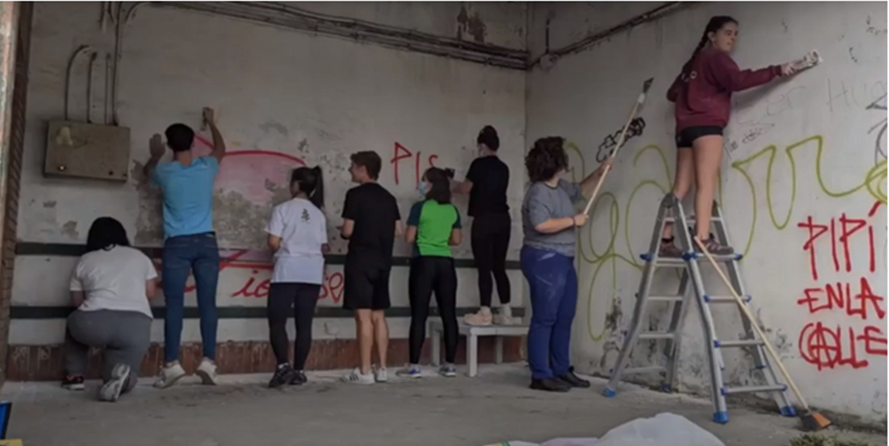
Next was the testing phase that lasted for a couple of weeks. During this period, a BBQ was organized to gather all the neighbors and make them aware of the new collective resource available for everyone in the island (i.e. the Erriberritu).
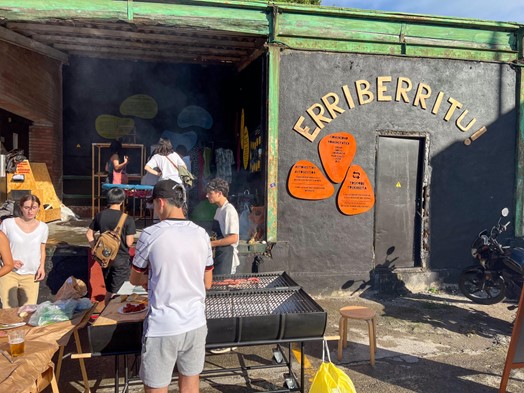
The BBQ was a great success in terms of participation and the students used this opportunity to gather some data from the participants through questionnaires. Following up on this event, the students observed the use of the space and generated metrics, such as the no. of users, no. of resources left or borrowed etc. This was the last action coordinated by the students, who then handed it over to the neighborhood and participated as users.
Developments beyond the academic year
After the end of the academic year in June 2023, a new validation phase started. This time it was set in a more organic way in which the students did not participate. Instead, people from the T-Factor local partners went through a daily observation of the developments around Erriberritu. This phase lasted the whole summer and the main result was the realization that the prototype was a success, since it was really used by the neighbors. Thus, the prototype could become a permanent use. Hence, T-Factor partners decided to invest more resources on the prototype to build it with stronger and better materials since during the testing phase the prototype suffered from the weather and use.
This third validation phase and its resultant moving from “prototype” to “permanent”, was one of the main outcomes of the project. The students were informed about this development, which made them very proud. Another important outcome of this initiative was the involvement of one of the students (as their representative) in the Civic Design Council (CDC). This student actively participates in all regular meetings that the CDC hosts and is the liaison with the other 22 students of MU.
Key Learnings
The idea of connecting HEI with grassroots initiatives has been explored before. Still, the profile of the Bilbao pilot (i.e the active participation of grassroots initiatives and the dedication of the MU in running this pilot project) in combination with the participation of external experts/observers (i.e. Tecnalia and Universita Oberta de Catalunya) created a unique ecosystem where such an education program can thrive and showcase its full potential. The key learnings identified through this experience can be summarized as follows:
- The success of such curricula is highly dependent on inclusivity. The continuous involvement of stakeholders at multiple levels and the identification of points of interaction is key.
- The objectives, expectations and resources for each stakeholder (i.e. students, grassroots initiatives, etc) should be clearly defined from the beginning. This helps avoid misunderstandings, frustration and false expectations.
- The developed prototypes should meet existing needs of the local community. That’s how they will stay connected. Still, it is not always easy to match the interests and enthusiasm of students with the actual needs of local stakeholders. As seen in our case, students were initially frustrated with the selection of the prototype to be developed, which was different from the one they voted for.
- Planning the steps to be taken after the end of the curriculum (e.g. validation process, future of the prototype, etc) is vital.
- Although purely technological (i.e. “hard skills”) have been important in the prototype development phase, in the previous phases of needs identification and prototype design, the collaboration between HEIs and grassroot initiatives has proved to be an ideal field for the development of “soft skills” such as active listening, critical thinking, emotional intelligence, resilience and change management.
- Empathy is a crucial skill that students can develop through such initiatives. It is also considered necessary in actively engaging with local stakeholders.
- Student profiles such as the Global Digital Humanities students have proven capable of taking on and understanding the complex challenges that cities and urban environments face. This has been recognised by the Municipality as a valuable profile for the design of the cities of the future.
- Local Administration plays an essential role and is a double-edged sword in these processes. On the one hand, its presence as a member of the CDC and certain past inertia among the agents inhabiting the island have led to blockages in the process, lack of commitment and phases of lack of definition. Still, the Local Administration has also been important to count on as a legitimizing agent capable of making decisions that transcend the project. Hence, the involvement of local or regional authorities should also be taken into account when designing collaborations between HEIs and grassroot initiatives.
To conclude, meanwhile uses can provide fertile ground for impactful collaboration between HEIs and local grassroots initiative. Similar activities could be initiated by public institutions such as municipalities, museums, and libraries. Further, municipalities could provide support to private organizations to set up such inclusive curricula that can benefit the local communities.
Meanwhile Learning Innovation Jam
Design a learning module that leverages the meanwhile in urban regeneration in address to sustainable urban development challenges